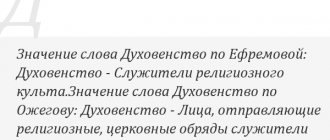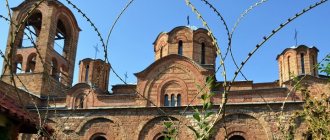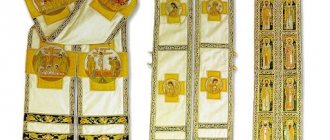Clergy
Servants of the Church who, in the Sacrament of the Priesthood, receive a special gift of the grace of the Holy Spirit to perform the sacraments and worship, teach people the Christian faith and manage the affairs of the Church. There are three degrees of priesthood: deacon, priest and bishop. In addition, the entire clergy is divided into “white” - priests who are married or have taken a vow of celibacy, and “black” - priests who have taken monastic vows.
A bishop is appointed by a council of bishops (that is, several bishops together) in the Sacrament of the Priesthood through a special episcopal consecration, that is, ordination.
In the modern Russian tradition, only a monk can become a bishop.
The bishop has the right to perform all sacraments and church services.
As a rule, a bishop is at the head of a diocese, a church district, and cares for all the parish and monastic communities included in his diocese, but he can also perform special church-wide and diocesan obediences without having his own diocese.
Orthodox clergy (Orthodox hierarchy).
Simultaneously with the establishment of Christianity as the state religion under the holy Equal-to-the-Apostles Prince Vladimir, the baptist of Kievan Rus (988), the Orthodox clergy also appeared in the country. As in Byzantium, the Russian clergy was initially a privileged class. Monasticism was especially respected in Ancient Rus' as the destiny of the chosen saints of God, the stronghold of a pious prayer life. Rich and noble people often entered the monasteries; the princes gave privileges to the monasteries. Income from the monastery estates went partly to support the brethren, partly to charity, and were exempt from any exactions in favor of the prince. The predominant type of ancient Russian monasteries was a community organized on the basis of a communal life, modeled on the Byzantine Studite monastery, the charter of which was introduced by Saint Theodosius of Pechersk in the Kiev-Pechersk Lavra. The brethren in the monasteries themselves elected the abbot; The brethren judged the guilty monks and took part in the economic affairs of the monastery. The first Russian hierarchs also came out of monasteries. At the head of the Russian clergy was the metropolitan, initially elected and installed in Constantinople almost exclusively from the Greeks, and neither the Russian clergy nor the Grand Duke took part in his election: the consent of the latter began to be taken into account only from the 12th century. This order was maintained until 1589, when, at the request of Tsar Theodore Ioannovich, Patriarch Jeremiah of Constantinople installed Job as Russian patriarch. The rights and benefits of the former metropolitan were transferred to the patriarch. Like the metropolitan, the patriarch was elected by the Council of Russian bishops and confirmed by the tsar.
In Christianity there are three hierarchical degrees (ranks) of the clergy: bishopric, presbytery and deaconry. Subsequently, according to the established Orthodox tradition. In the East of tradition, two more types of clergy began to be distinguished - black (monastic, unmarried) and white (parish, married). In the Western Church, among Catholics, all clergy take a vow of celibacy (the so-called celibacy).
Belonging to the clergy is determined by the special church sacrament of the priesthood, which is performed only on a male person who belongs to the clergy, an Orthodox believer, who is in a first marriage, sanctified by the church, or who has taken monastic vows and has been chosen for elevation to one of the three degrees of the church hierarchy: deacon, presbyter or bishop.
See further:
Deacon (Greek “diakonos” - servant),
Presbyter (Greek “presbyteros” - elder),
Bishop (Greek “episkopos” - overseer),
Patriarch (father leader).
Metropolitans and bishops were the most educated people in Rus', hence their high position in ancient Russian society and quite significant influence in public life. The highest clergy sat in the princely Duma; His representatives carried out diplomatic missions, reconciled princes, interceded for the disgraced, for the people ruined by constant wars.
Holy Prince Vladimir assigned tithes from his princely incomes for the maintenance of the higher clergy, which later turned into taxes from the laity. In addition, metropolitans and bishops received income from cathedral churches, fees for performing services, voluntary offerings, duties on trade measures and weights, the supervision of which they were entrusted with, judgments from church courts, annual dues from the lower clergy, set duties, temporary duties from the laity, such as, for example, a wedding fee for blessing marriages, and, finally, income from real estate. The higher clergy was free from duties and taxes.
The financial position of the lower white clergy was very unenviable, as a result of which, despite complete freedom to enter the clergy, they attracted only the poorest segments of the population. The main contingent of the white clergy were the children of clergy. At first there was a shortage of priests; the government itself had to take care of the formation of parishes. Subsequently, the formation of parishes and the choice of candidates for priestly positions depended, on the one hand, on the parish communities, on the other, on the patrimonial landowners. The votchinnik filled vacant positions mainly with his own serfs, declaring them free before initiation. The community elected a candidate and entered into an agreement with him, which determined the term of service and the obligations of each party. During the appanage period, in addition to priests, deacons were only occasionally found at churches, but sextons were constantly present, that is, readers, or sextons. The lower white clergy lived mainly on payments for performing church sacraments and services (baptisms, weddings, funeral services, prayer services, etc.).
The legal codes of Ivan III and Ivan IV, as well as the decisions of the Stoglavy Church Council (1551), laid the foundation for the differentiation of church and civil departments; it was recognized that the clergy was not subject to the jurisdiction of the secular court in all cases, except for criminal cases (until the defrocking of the offender was defrocked). In the 17th century, the isolation of the clergy was preserved, but already in the next century, simultaneously with the abolition of the patriarchate by Peter I, the clergy was subordinated to the control and court of civil power, and the clergy was deprived of privileges and benefits. The nature of the relationship between the state and the church, which determined the position of the clergy in Russia, was preserved under the successors of Peter I until the October Revolution of 1917. During the period of dominance of state atheism in the USSR (1922-1991), the Orthodox clergy was persecuted and discriminated against. Hundreds of thousands of clergy were repressed and died in prison. During the years of “perestroika” the position of the Russian Orthodox Church changed significantly. At present, the Russian Orthodox clergy is gradually again taking its rightful place in the life of society.
V. A. Nikitin
Here is quoted from the publication: Religions of the peoples of modern Russia. Dictionary. / editorial team: Mchedlov M.P., Averyanov Yu.I., Basilov V.N. and others - M., 1999, p. 358-361.
Bishop titles
Bishop
An archbishop is the oldest, most honored bishop.
Metropolitan is the bishop of the main city, region or province or the most honored bishop.
Vicar (lat. vicar) - bishop - assistant to another bishop or his vicar.
The Patriarch is the chief bishop in the Local Orthodox Church.
The priest is ordained by the bishop in the Sacrament of the Priesthood through priestly ordination, i.e. ordination.
The priest can perform all divine services and sacraments, except for the consecration of the chrism (the oil used in the Sacrament of Confirmation) and antimensions (a special plate consecrated and signed by the bishop, on which the liturgy is performed), and the Sacraments of the Priesthood - these can only be performed by the bishop.
A priest, like a deacon, as a rule, serves in a specific church and is assigned to it.
The priest at the head of the parish community is called the rector.
Hierarchy of the white clergy
At the head of the Russian Orthodox Church is the Primate - the Patriarch of Moscow and All Rus'. Together with the Holy Synod, it administers church affairs.
The Metropolitan is immediately responsible for several dioceses. Bishops do not make important decisions without the knowledge of the Metropolitan.
Each diocese has its own Bishop, who is responsible for the area assigned to him. Absolutely all bishops belong to the black clergy. Bishops are responsible for large dioceses.
Next in seniority are the priests and archpriests. Archpriest - a priest who has received a special award. Through the sacrament of consecration, priests receive a new status.
There are also deacons and protodeacons who assist the priest and archpriest during services. A deacon cannot conduct divine services on his own.
Thus, the hierarchy in the white clergy looks like this:
- Patriarch
- Metropolitan
- Bishop/Bishop
- Priest/Archpriest
- Deacon/protodeacon
Titles of priests
from the white clergy Priest
Archpriest - the first of the priests, usually an honored priest.
Protopresbyter is a special title, awarded rarely, as a reward for the most worthy and honored priests, usually rectors of cathedrals.
from the black clergy
Hieromonk
Archimandrite (Greek head of the sheepfold) - in ancient times the abbot of individual famous monasteries, in modern tradition - the most honored hieromonk or abbot of the monastery.
Hegumen (Greek leader)
currently the abbot of the monastery. Until 2011 - Honored Hieromonk. When leaving the position of abbot, the title of abbot is retained. Those who were awarded the rank of abbot before 2011 and who are not abbots of monasteries are retained this title.
A bishop ordains a deacon in the Sacrament of the Priesthood through deacon ordination, i.e. ordination.
The deacon assists the bishop or priest in performing divine services and sacraments.
The participation of a deacon in divine services is not obligatory.
New in blogs
Today’s message is devoted to the rather confusing scheme of the Orthodox priesthood, in which not only journalists, but also fellow religious scholars often make mistakes. In addition, in this message we will begin a topic that will be developed in the next post - about names in a person’s life and the connection of names with religion. The Orthodox clergy (aka clergy) is divided into two branches - white and black. White clergy, unlike black clergy, can marry and have children. Black, monastic clergy take a vow of celibacy.
Representatives of the white clergy begin with the rank of
deacon (Greek minister) (the lowest, first step; they cannot perform the sacraments and conduct the service independently). There are two honorary titles - protodeacon (Greek first minister) (the main deacon in the diocese, often granted as a sign of special merit, or after 20 years of blameless service) and archdeacon (Greek chief minister) (among the white priesthood this can only be the patriarchal deacon ). There is also an interesting precedent - for the only time in the history of the Russian Orthodox Church, Archdeacon K.V. Rozov, in honor of the 25th anniversary of his diaconal service and in commemoration of his merits, was given the unique title of Great Archdeacon (in 1921).
The subdeacon does not belong to the clergy - he is a senior clergyman who carries out auxiliary actions for a high-ranking priest; an intermediate link between clergymen (psalm-readers, bell-ringers, prosphora players, etc.) and clergy. After ordination, the priest becomes a priest (Greek priest), or presbyter (Greek elder) (also most often, by priest in the proper sense of the word they mean precisely this, the second level of the priesthood). He can perform the sacraments (except for ordination) and lead the service. There are also honorary titles. The first is the archpriest (Greek first priest) (usually the rector of the temple; in the old terminology - archpriest). Such a title is usually given as a reward no less than 10 years after ordination to the priesthood, and, in addition, it is possible to elevate a protodeacon directly to archpriest, bypassing the priestly rank. The second title - protopresbyter (Greek: chief elder) - is the highest rank available to the white clergy, and is currently awarded “in exceptional cases, for special church merit, on the initiative and decision of His Holiness the Patriarch.”
The black clergy - monks - begin the first step with the rank of
hierodeacon (Greek: sacred minister, i.e. a monk in the rank of deacon). A senior monk may bear the title of archdeacon as a sign of merit, often in large monasteries.
A monk of the second degree, ordained a priest, bears the rank of hieromonk (Greek: sacred solitary). Only from among the hieromonks is the abbot (Greek leader) - the abbot of the monastery - elected. There is also an honorary title - archimandrite (Greek chief of the monastery) (approximately equivalent to protopresbyter). Archimandrites most often become the abbots of the largest and most important monasteries, or persons occupying large church administrative positions related to the functioning of the monastery.
Only monks have access to the third, highest level of clergy—bishopricism (Greek: chief priest). It is bishops who can perform the sacrament of ordination, and calling them “priests” is terminologically incorrect. Jesus Christ himself is called by the Apostle Paul “a bishop according to the order of Melchizedek forever” (in the Epistle to the Hebrews).
The first rank of bishop is the rank of bishop (Greek: overseer). The bishop usually "runs" a region or diocese, although there are exceptions. Again, there is the honorary title of archbishop (Greek: chief overseer), which is most often awarded for merit, and in some cases to the head of a large diocese, although at various historical periods archbishops could lead entire churches. Thus, dioceses that include vicariates are almost always headed by archbishops. Another honorary title - metropolitan (Greek, located in the main city) - is assigned to the head of the metropolis - a large region (district) uniting several dioceses.
The highest rank of bishop is the rank of patriarch (Greek: chief father). Historically assigned to the most important bishops; then basically means the primate who heads an autocephalous (independent) church. The Patriarch of Moscow and All Rus' currently heads the Russian Orthodox Church, “has primacy of honor among bishops and is accountable to the Local and Bishops’ Councils.” In addition, the patriarchs are the primates of the Bulgarian, Georgian, Serbian, Romanian and some other churches (in particular, the Catholic metropolises of Venice and Lisbon!).
In addition, within monasticism itself there are degrees of initiation that determine the stage and depth of immersion in the monastic way of life.
Before being tonsured as a monk, a person must go through a stage of novitiate . No vows have yet been made; you need to prepare yourself for tonsure and get used to monastic activity. It is allowed to wear a cassock as clothing.
The next stage is tonsure, after which the person changes his name and becomes a ryassophore (wearing a cassock), monk or monk . The only vow he takes is the vow of obedience; he is allowed to wear a cassock and a hood with rosary. Since it is customary to ordain only monks as bishops, the ryassophore is already a sufficient degree for episcopal ordination (subject to acceptance of celibacy) - in contrast to the Greek tradition, where the ryassophore retains a secular name and is free to return to ordinary life.
After this, the monk can accept the small or mantle schema. He changes his name again, becomes a monk in the full sense of the word, and takes the following vows - obedience, celibacy, non-covetousness and unceasing prayer. You need to choose an elder - a spiritual mentor, whom you should obey. In addition to this, the monk is assigned certain prayer rules, and he is obliged to carry out monastic service. A monk, in addition to his previous attire, may wear a tunic, a paraman (a square with inscriptions and a cross) and a pallium mantle.
Finally, a monk can accept the great schema and become a schemamonk, schema-monk , or monk of the great schema . His name is changed again, he takes special vows and usually lives separately from the brethren. It is schemamonks who usually perform the highest monastic feats, and they are called accordingly: hermits, hermits, hermits, stylites. Schemamonks, in addition to the previous clothes, wear special paramans and a doll hood.
A schemamonk who has the rank of priest is called a hieroschemamonk . An archimandrite who has accepted the schema is called a schema-archimandrite .
I hope that now the system of Orthodox titles has become easier to understand! If necessary, you need to make a suitable diagram to show how the “development” is going along one or another path of the cleric (leveling up, yes xDD)
It is interesting that with each new name change, the monk seems to die for the old world and is born again, and at the same time, more and more new intercessors appear for him. This tradition is characteristic not only of monasticism, and we will talk about names, naming and choosing pseudonyms in the next post. Thank you for attention!
Clergymen
They are not part of the main clergy hierarchy. These are ministers of the Church who are appointed to their positions not through the Sacrament of Priesthood, but through ordination, that is, with the blessing of the bishop. They do not have the special gift of grace of the Sacrament of the Priesthood and are assistants to the clergy.
Subdeacon - participates in bishop's services as an assistant to the bishop.
Psalmist/reader, choirboy - reads and sings during services.
Sexton/altar boy is the most common name for assistants in worship. Calls believers to worship by ringing bells, helps at the altar during services. Sometimes the duty of ringing bells is entrusted to special servants - bell ringers, but not every parish has such an opportunity.









